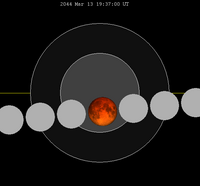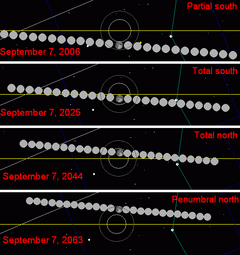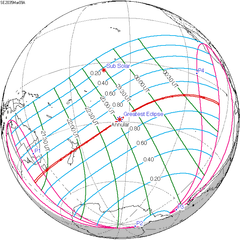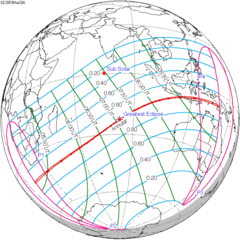|
March 2044 lunar eclipse
A total lunar eclipse will occur at the Moon’s descending node of orbit on Sunday, March 13, 2044,[1] with an umbral magnitude of 1.2050. A lunar eclipse occurs when the Moon moves into the Earth's shadow, causing the Moon to be darkened. A total lunar eclipse occurs when the Moon's near side entirely passes into the Earth's umbral shadow. Unlike a solar eclipse, which can only be viewed from a relatively small area of the world, a lunar eclipse may be viewed from anywhere on the night side of Earth. A total lunar eclipse can last up to nearly two hours, while a total solar eclipse lasts only a few minutes at any given place, because the Moon's shadow is smaller. Occurring about 6.2 days after perigee (on March 7, 2044, at 15:30 UTC), the Moon's apparent diameter will be larger.[2] This lunar eclipse is the third of a tetrad, with four total lunar eclipses in series, the others being on March 25, 2043; September 19, 2043; and September 7, 2044. VisibilityThe eclipse will be completely visible over east Africa, eastern Europe, and much of Asia, seen rising over west Africa, western Europe, and eastern South America and setting over northeast Asia and Australia.[3]
Eclipse detailsShown below is a table displaying details about this particular solar eclipse. It describes various parameters pertaining to this eclipse.[4]
Eclipse seasonThis eclipse is part of an eclipse season, a period, roughly every six months, when eclipses occur. Only two (or occasionally three) eclipse seasons occur each year, and each season lasts about 35 days and repeats just short of six months (173 days) later; thus two full eclipse seasons always occur each year. Either two or three eclipses happen each eclipse season. In the sequence below, each eclipse is separated by a fortnight.
Related eclipsesEclipses in 2044
Metonic
Tzolkinex
Half-Saros
Tritos
Lunar Saros 133
Inex
Triad
Lunar eclipses of 2042–2045This eclipse is a member of a semester series. An eclipse in a semester series of lunar eclipses repeats approximately every 177 days and 4 hours (a semester) at alternating nodes of the Moon's orbit.[5] The penumbral lunar eclipse on October 28, 2042 occurs in the previous lunar year eclipse set.
Metonic seriesThe Metonic cycle repeats nearly exactly every 19 years and represents a Saros cycle plus one lunar year. Because it occurs on the same calendar date, the Earth's shadow will in nearly the same location relative to the background stars.
Saros 133This eclipse is a part of Saros series 133, repeating every 18 years, 11 days, and containing 71 events. The series started with a penumbral lunar eclipse on May 13, 1557. It contains partial eclipses from August 7, 1683 through December 17, 1899; total eclipses from December 28, 1917 through August 3, 2278; and a second set of partial eclipses from August 14, 2296 through March 11, 2639. The series ends at member 71 as a penumbral eclipse on June 29, 2819. The longest duration of totality will be produced by member 35 at 101 minutes, 41 seconds on May 30, 2170. All eclipses in this series occur at the Moon’s descending node of orbit.[6]
Eclipses are tabulated in three columns; every third eclipse in the same column is one exeligmos apart, so they all cast shadows over approximately the same parts of the Earth.
Tritos seriesThe tritos series repeats 31 days short of 11 years at alternating nodes. Sequential events have incremental Saros cycle indices. This series produces 23 total eclipses between June 22, 1880 and August 9, 2120.
Half-Saros cycleA lunar eclipse will be preceded and followed by solar eclipses by 9 years and 5.5 days (a half saros).[8] This lunar eclipse is related to two annular solar eclipses of Solar Saros 140.
See alsoReferences
External links
|
|||||||||||||||||||||||||||||||||||||||||||||||||||||||||||||||||||||||||||||||||||||||||||||||||||||||||||||||||||||||||||||||||||||||||||||||||||||||||||||||||||||||||||||||||||||||||||||||||||||||||||||||||||||||||||||||||||||||||||||||||||||||||||||||||||||||||||||||||||||||||||||||||||||||||||||||||||||||||||||||||||||||||||||||||||||||||||||||||||||||||||||||||||
















































































